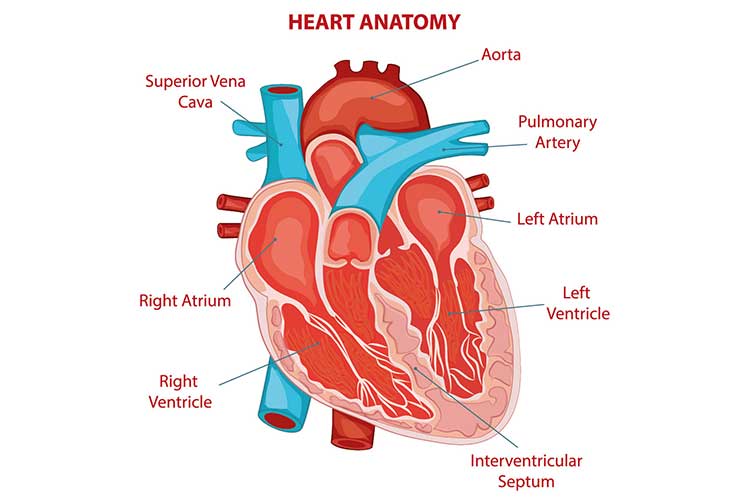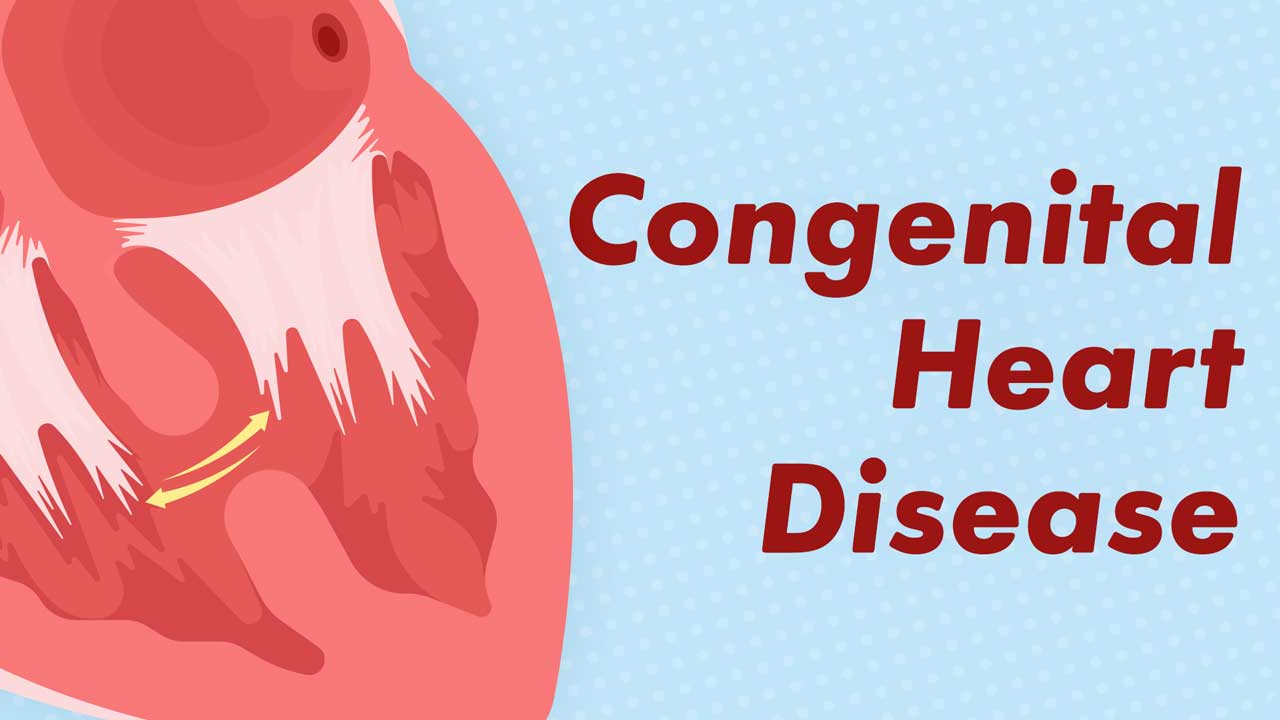Congenital heart disease (CHD) is a general term used to describe a variety of birth defects that affect the normal functioning of the heart (NHS 2021).
Congenital heart defects are structural problems with the heart that present at birth. They can occur if the heart, heart valves or blood vessels don't develop properly before the baby is born (Heart Foundation 2024).
About 1 in 100 babies are born with CHD (Better Health Channel 2024).
The Heart
The heart is divided into four chambers that are separated by a wall called the septum. The four chambers are:
(i) Two upper chambers called the atria:
- Left atrium: collects blood returning from the lungs
- Right atrium: collects blood returning from the body.
(ii) Two lower chambers called the ventricles:
- Right ventricle: pumps blood to the lungs
- Left ventricle: pumps blood to the body.
There are also four heart valves that control how blood flows through the heart chambers and around the body:
- Mitral valve: Separates the left atrium and the left ventricle
- Aortic valve: Separates the left ventricle from the aorta
- Tricuspid valve: Separates the right atrium and the right ventricle
- Pulmonary valve: Separates the right ventricle from the pulmonary artery.
(Better Health Channel 2022; Cleveland Clinic 2022)

Causes of Congenital Heart Disease
Certain genetic and environmental risk factors may contribute to the development of a congenital heart defect. These include:
- Poorly controlled diabetes during pregnancy
- Taking certain medicines while pregnant
- Rubella infection during pregnancy
- Genetics
- Smoking and drinking during pregnancy.
(Mayo Clinic 2024)
Symptoms of Congenital Heart Disease
These may include:
- Abnormal heart rhythms
- Shortness of breath
- Swelling of body tissue or organs
- Excessive sweating
- Extreme tiredness and fatigue
- A blue tinge to the skin, lips and fingernails (cyanosis).
(Mayo Clinic 2024)
Types of Congenital Heart Diseases
There are many types of congenital heart disease, but some of the most common conditions include:
- Coarctation of the aorta, where the longest blood vessel in the body (the aorta) is narrower than normal.
- Atrial septal defect, where there is a hole between two of the heart's chambers.
- Pulmonary valve stenosis, where the pulmonary valve is narrower than normal.
- Transposition of the great arteries, where the pulmonary and aortic valves and the arteries they are connected to have swapped positions.
(American Heart Association 2022)
Impact of Congenital Heart Defects
Congenital heart disease can increase the risk of developing other medical conditions, such as:
- Heart infection (endocarditis): The heart has a thin inner lining called the endocardium. Endocarditis is an infection of this inner lining caused by bacteria entering the bloodstream and settling in the heart lining. Untreated, endocarditis can damage or destroy the heart valves.
- Abnormal heart rhythms: A non-functional valve or malformed section of the heart can alter its rhythm, causing it to beat too fast, too slowly or irregularly.
- Heart failure: Also known as congestive heart failure, this condition means that the heart is not able to pump enough blood to meet the body's needs. It may be caused by a defect in the heart that prevents blood from getting out into the circulation, thereby causing extra fluid to build up in the lungs, liver, around the eyes and sometimes in the legs.
- Stroke: Occurs when blood suddenly cannot get through to part of the brain, depriving the brain tissue of oxygen. A congenital heart defect can allow a blood clot to pass through the heart and travel to the brain, triggering a stroke.
- Pulmonary hypertension: Affects the arteries that supply blood to the lungs. Congenital heart defects can cause the blood pressure in the lungs to become higher than normal, increasing pressure on the heart to pump. This can eventually cause the heart muscle to weaken, causing the person to become tired, dizzy and short of breath.
(American Heart Association 2024)
Maintaining Heart Health
- Eat a well-balanced diet
- Keep your follow-up appointments with your cardiologist
- Always take medicines as prescribed by your healthcare professional
- Make sure you have the necessary tests done when your doctor orders them
- Always follow any physical activity recommendations and restrictions by your cardiologist or doctor.
(Mayo Clinic 2022)
The most important step in managing congenital heart disease is to know the type of existing defect, understand what it means and be able to follow the recommended care options. Increasing your knowledge in new ways, for example, by participating in research to help improve or better understand your heart defect, can help to improve the effects of congenital heart disease.
Topics
Further your knowledge
References
- American Heart Association 2022, Common Types of Heart Defects, American Heart Association, viewed 17 July 2024, https://www.heart.org/en/health-topics/congenital-heart-defects/about-congenital-heart-defects/common-types-of-heart-defects
- American Heart Association 2024, The Impact of Congenital Heart Defects, American Heart Association, viewed 17 July 2024, https://www.heart.org/en/health-topics/congenital-heart-defects/the-impact-of-congenital-heart-defects
- Better Health Channel 2024, Congenital Heart Disease, Victoria State Government, viewed 17 July 2024, https://www.betterhealth.vic.gov.au/health/conditionsandtreatments/congenital-heart-disease
- Cleveland Clinic 2022, Heart Chambers, Cleveland Clinic, viewed 17 July 2024, https://my.clevelandclinic.org/health/body/23074-heart-chambers
- Better Health Channel 2022, Heart Explained, Victoria State Government, viewed 17 July 2024, https://www.betterhealth.vic.gov.au/health/conditionsandtreatments/heart
- Cleveland Clinic 2022, Heart Chambers, Cleveland Clinic, viewed 17 July 2024, https://my.clevelandclinic.org/health/body/23074-heart-chambers
- Heart Foundation 2024, Congenital Heart Conditions, Heart Foundation, viewed 17 July 2024, https://www.heartfoundation.org.au/your-heart/congenital-heart-conditions
- Mayo Clinic 2024, Congenital Heart Disease in Adults, Mayo Clinic, viewed 17 July 2024, https://www.mayoclinic.org/diseases-conditions/adult-congenital-heart-disease/symptoms-causes/syc-20355456
- Mayo Clinic 2022, Heart Disease, Mayo Clinic, viewed 17 July 2024, https://www.mayoclinic.org/diseases-conditions/heart-disease/diagnosis-treatment/drc-20353124
- National Health Service 2021, Congenital Heart Disease, NHS, viewed 17 July 2024, https://www.nhs.uk/conditions/congenital-heart-disease/
 New
New 

